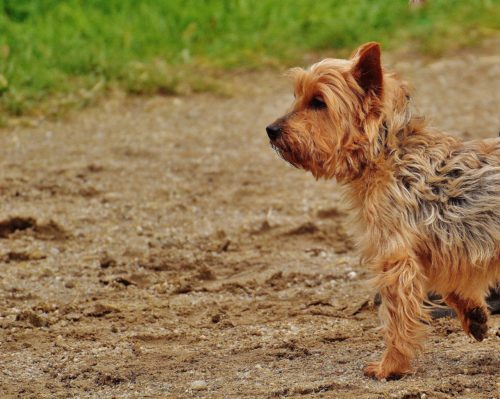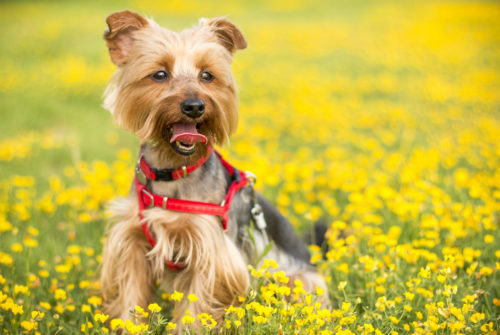Yorkshire Terriers are considered to be working dogs but can be strong-willed and have big dog temperament in a small dog’s body. Luckily, Yorkshire Terriers are very trainable, and there are a variety of different Yorkshire Terrier dog training tips and techniques.
The foundation for all training techniques include:
- Consistency
- Repetition
- Positive or Negative Consequences/Reinforcement
Start Yorkie Training Early
If you need to know how to train a Yorkie puppy, you should note that it’s easier to train a dog at a young age. As the saying goes “you can’t teach an old dog new tricks.” Try to begin house training your Yorkie dog as early as 7 to 8 weeks old. It is also best to train them without inducing anxiety and stress.

He will still have a short attention span but can learn basic commands such as “sit,” “down,” and “stay.”
You can still train your older Yorkie, but it is a bit more difficult, and you may need to consult a professional trainer if your Yorkie is over 1 year old.
Clicker Training
This technique involves using a clicker to create a noise when a desired action is done, followed by a treat like CBD for pets to your adult dog or Yorkie pup.
licker training is a type of positive reinforcement training that uses proven behavioral science methods to communicate and interact with your adult dog or puppy.
The timing of the click is important because it lets your Yorkie know exactly what behavior he did that got him a treat. Often, when a dog is learning a new trick such as sitting, he will sit for a just a second, then stand up to get the treat. Making the noise when he is physically sitting makes it clear that the sitting behavior is what he is being rewarded for.
To start this training, simply begin by introducing the click noise. Always follow it with a treat, even if it was clicked on accident. You may use a verbal word marker like “good boy/girl” instead of a clicker.
Never use the clicker to get your dog’s attention. The noise is meant to be associated with good behavior only. Over time, your dog will associate the clicker noise with getting a treat or reward. Once this happens, you can begin the training process.
After your Yorkie has become good at clicker training, try to make him follow two commands, each getting their own click, then giving him a treat. This will ensure your pup will listen to your commands regardless of an immediate treat. This doesn’t go against the golden rule of always following the click with a treat, because he is still receiving a treat like the CBD for dogs at the end.
Only use the clicker to teach new behaviors or to refine behaviors. If your Yorkie is a pro at sitting on command, you don’t need to click and treat every time. A simple praise should be a sufficient reward, but never stop rewarding good behavior!
Teaching Commands
Using simple command words to elicit a behavior from your dog is a powerful tool and quite easy to do. When teaching your dog a behavior, say the command word or phrase and guide them to do the behavior, then follow the completed behavior with a reward. Make sure to use words or phrases that sound distinct from each other. The commands “lay” and “stay” sound similar, so consider switching one of them to avoid confusing your dog (for example, instead of “lay,” use “down”).
Respect Training
All previous training techniques are examples of positive reinforcement training. This type of training works well for teaching dogs fun tricks, but when it comes to teaching your dog to obey, negative consequence training is much more effective. With positive only training, your dog may choose not to obey if he doesn’t want a treat. Of course, you may choose your own way to train your Yorkie.

Respect training is a balanced way of training a Yorkie. A Yorkie will receive both negative and positive consequences for their behavior.
Many people are against using negative consequences for training, but it is important to learn from both types of consequences.
Negative consequences can be done by a change of voice, facial expression, body language, crate time-outs, or using a leash.
You should never punish your dog by hitting, using choke/shock collars, or any other form of harmful treatment. However, if your dog acts out, make sure that he knows this behavior doesn’t make you happy.
Make sure your dog is paying attention to you when you are verbally telling him he did something wrong. Often, your dog will avoid eye contact because he knows what he did was bad. Try to build a foundation of respect with your dog. Once your Yorkie respects you, he will listen to you no matter what the circumstance is.
Yorkie Potty Training
Holding Duration
The rule of thumb for any dog being able to go without a bathroom break is 1 hour for every month old he is, up until the maximum of 12 hours (12 months and older). Therefore, a one-month-old Yorkie puppy can last 1 hour, a two-month-old puppy can last 2 hours, and so on. Keep in mind that your Yorkie should not have to hold potty breaks for 12 hours normally.
Find a Rhythm in Potty Frequency
Start by tracking when your dog ate, when he had to go potty, what kind of potty, and where he went potty (inside or outside). After a while, you will begin to see a rhythm of when he eats and drinks and when he goes potty. You will also begin to notice telltale signs that your dog exhibits before going potty, such as restlessness, pacing, whining, etc. Keep an eye out for these signs and act immediately to avoid accidents.

Frequency of Potty Breaks
Before you figure out your dog’s own natural potty break frequency, take him out every 2-3 hours and about 15 minutes after eating a meal.
This is when he will most likely have a bowel movement. Note that up until your dog is about 4 months old, you must take him out at least once during the night.
Make sure that he walks to the spot on a leash or follows you to the spot to ensure he doesn’t get used to you carrying him every time he needs to go.
Use a Crate
The best way to avoid accidents in the house is to employ dog crate training. This involved putting your pup in a crate whenever he is not being watched. Dogs are clean by nature and don’t want to soil the place that they lay. Therefore, your dog will avoid having to use his crate as a potty spot by all means. Until he is housebroken, don’t let your Yorkie wander the house freely.
Make sure to keep on eye on him whenever he is outside of the crate. If you are gone for a long period of time during the day, use a closed off canine playpen. However, an extended period of time in a confined space during your dog’s wake hours can put stress on him.
To Potty Pad or Not to Potty Pad?
The downside of using a pee pad is that your dog may get used to them and start thinking it is fine to go in the house, so it is suggested to train him without a pee pad. Sometimes it’s not possible to train without them due to working long hours or not having a backyard, so don’t feel like you shouldn’t if you need to train your dog to use potty pads.

How to Train a Yorkie Where to Go Potty
Dogs learn from environmental cues, such as surrounding smells and voice commands. When potty training your puppy, begin taking him to the same spot.
After he gets the hang of it, you may let him go in other places, and eventually, let him decide where to go.
Use the basics mentioned above to begin training your Yorkie. If you need additional help you can take your dog to puppy training classes or hire a professional trainer.
Remember, it will take time and consistency. Before adding a Yorkie to your household it is important to understand the commitment of training.




